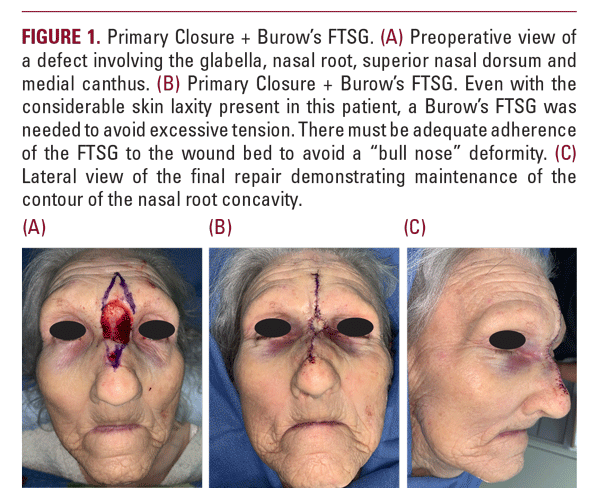INTRODUCTION
Reconstructive Options
Second Intention
Second intention (granulation) is an option for smaller glabellar and nasal root defects given the concave nature. Larger defects require closure to avoid atrophic or hypertrophic scarring, hasten healing, and avoid scar contraction which can distort free margins (Table 1).
Primary Closure +/- Burow's FTSG
A side-to-side (horizontal) primary closure can be utilized for smaller to moderate defects of the glabella and nasal root. However, it may lead to blunting of the nasal root concavity or accentuation of the convexity of the nasal dorsum. Care must be taken to avoid pulling up the nose. A combination closure utilizing a side-to-side primary closure with a V-to-Y advancement flap or Burow’s full-thickness skin graft (FTSG) from the glabella can be performed if primary closure alone is not feasible.
Primary closure with or without a Burow's FTSG is feasible for more moderate size defects of the midline glabella / nasal root if considerable laxity is present and if the medial displacement of the eyebrows does not cause synophrys (Figures 1A-C). For the vertical approach, the incision should be lengthened to a 4-5:1

Second Intention
Second intention (granulation) is an option for smaller glabellar and nasal root defects given the concave nature. Larger defects require closure to avoid atrophic or hypertrophic scarring, hasten healing, and avoid scar contraction which can distort free margins (Table 1).
Primary Closure +/- Burow's FTSG
A side-to-side (horizontal) primary closure can be utilized for smaller to moderate defects of the glabella and nasal root. However, it may lead to blunting of the nasal root concavity or accentuation of the convexity of the nasal dorsum. Care must be taken to avoid pulling up the nose. A combination closure utilizing a side-to-side primary closure with a V-to-Y advancement flap or Burow’s full-thickness skin graft (FTSG) from the glabella can be performed if primary closure alone is not feasible.
Primary closure with or without a Burow's FTSG is feasible for more moderate size defects of the midline glabella / nasal root if considerable laxity is present and if the medial displacement of the eyebrows does not cause synophrys (Figures 1A-C). For the vertical approach, the incision should be lengthened to a 4-5:1







